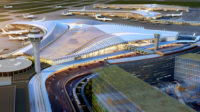Five teams competing to design a new park for Manhattan’s West Side recently unveiled their proposals. Led by the Hudson Yards Development Corporation, the Hudson Park and Boulevard project will cover 4 acres stretching from West 33rd to West 42nd Street, between 10th and 11th Avenues—an area presently occupied by a hodgepodge of buildings, rail lines, and roads leading to the Lincoln Tunnel. To the south, the park would connect to the Hudson Rail Yards, a 26-acre mixed-use development that calls for office towers, residential buildings, stores, and parks to be built on a massive platform over existing train tracks. Both projects are part of an initiative to transform an uninviting, semi-industrial area into a popular live-work-play destination.
The Hudson Park and Boulevard proposals are as follows:
- A team led by Work Architecture Company and Balmori Associates envisions a “Wild West Side,” where “Times Square meets Central Park,” says Work principal Dan Wood, AIA. The plan calls for undulating, grassy hills with space for cafes and other facilities underneath. Other features include urban gardens, a new animal habitat, and water collection systems that double as park furniture.
- A proposal from West 8, Mathews Nielsen, and Weisz + Yoes envisions a “primordial landscape,” with hills being constructed using schist excavated at nearby construction sites, says West 8 principal Jerry van Eyck. Features include a skateboard park, an art park, and a children’s activity area, as well as a kinked bridge that would bring pedestrians above roads leading to the Lincoln Tunnel and deliver them to West 42nd Street.
- A team led by Michael Van Valkenburgh Associates and Toshiko Mori took inspiration from Manhattan’s Union Square but rearranged the formal plan “into a kind of carpet,” explains MVVA principal Matthew Urbanski. Benches, plantings, and paved circulation routes similar to those in Union Square would be arranged in a more freeform scheme. Overhead lighting strung between buildings would illuminate the park, and an S-curve bridge with curled edges would bypass tunnel traffic.
- A plan from Hargreaves Associates and TEN Arquitectos calls for “ecological rooms,” from chestnut tree forests to pine barrens, describes Hargreaves principal Ken Haines. James Carpenter-designed light wands installed throughout the park would capture and redistribute sunlight. The scheme’s signature feature is a pedestrian bridge edged by a ribbon of grass that curls like a rollercoaster loop over the walkway.
- A proposal from Gustafson Guthrie Nichol and Allied Works Architecture would create a rolling “false topography,” says GGN principal Keith McPeters. Towering “prisms” and a winter garden would collect and redistribute sunlight, and wind funnels and turbines would generate power.
- A selection committee, whose members come from the Hudson Yards Development Corporation and numerous city departments, plans to announce a winner in late October, and Phase 1 of the project, running between West 33rd and West 36th Streets, is expected to be completed by 2013. The proposals are on view at New York’s Center for Architecture, 536 LaGuardia Place, through the end of October.













Post a comment to this article
Report Abusive Comment